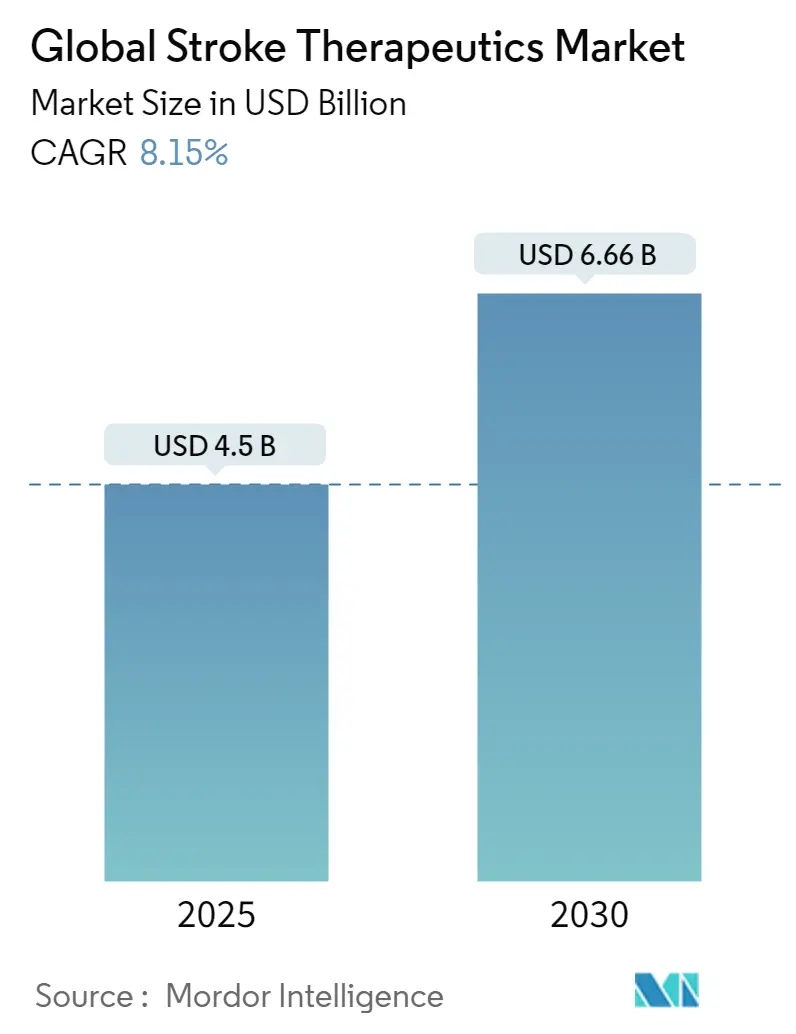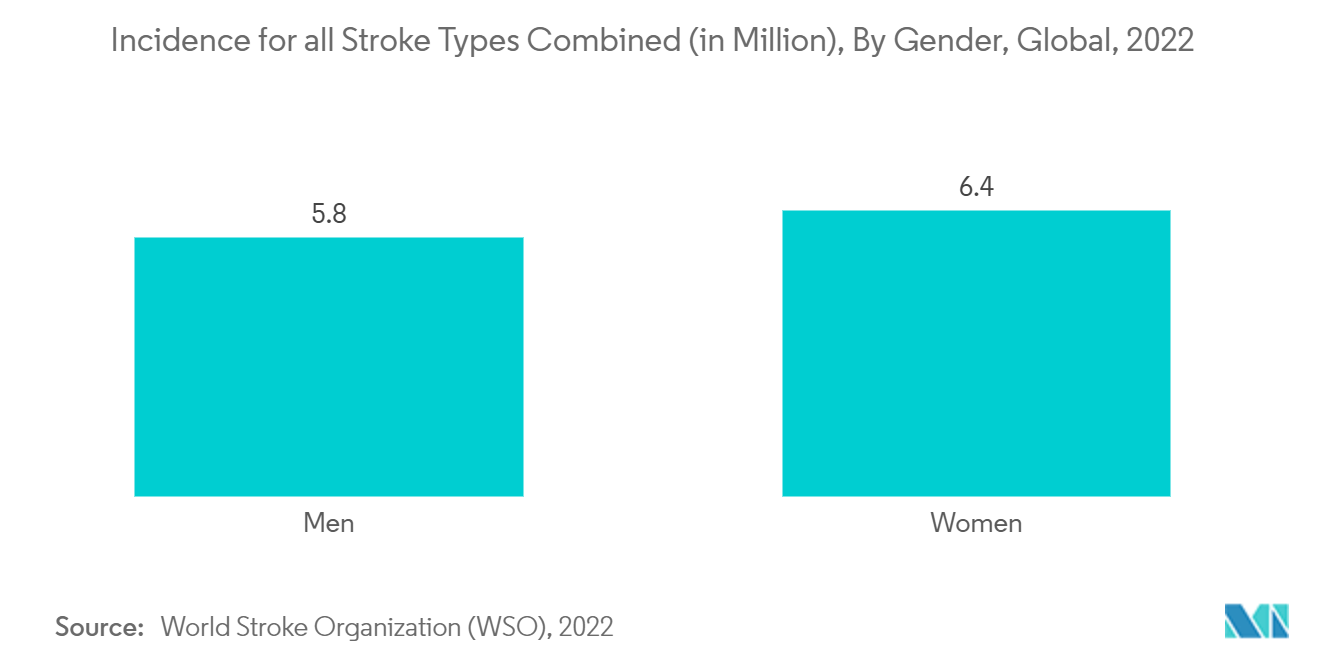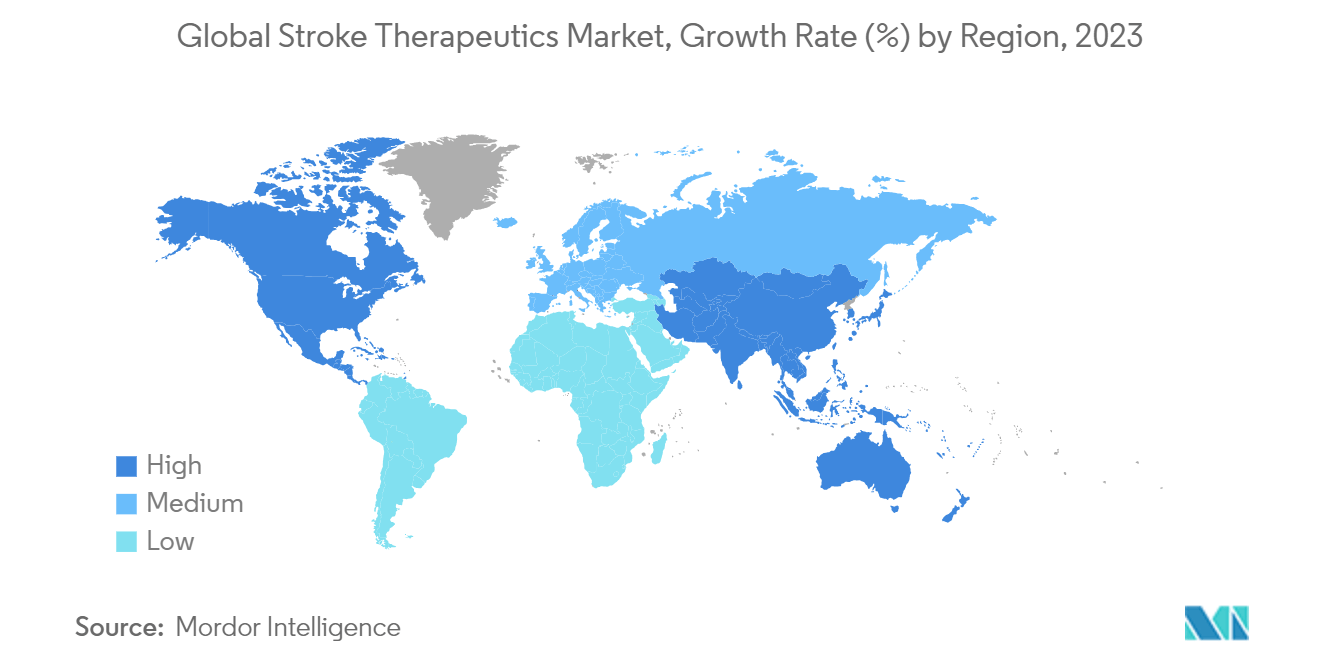Global Stroke Therapeutics Market Size and Share

Global Stroke Therapeutics Market Analysis by Mordor Intelligence
The Global Stroke Therapeutics Market size is estimated at USD 4.50 billion in 2025, and is expected to reach USD 6.66 billion by 2030, at a CAGR of 8.15% during the forecast period (2025-2030).
The stroke therapeutics market includes a range of interventions, from pharmacological treatments and medical devices to rehabilitation therapies. As risk factors like hypertension, diabetes, and an aging population become more prevalent, the market is poised for growth. Recent years have witnessed significant advancements in stroke therapeutics, fueled by innovative research, emerging technologies, and a deeper understanding of the biological mechanisms behind strokes. Given that strokes continue to be a leading cause of morbidity and mortality globally, the urgency for effective treatments is paramount.
Breakthroughs in stroke research are paving the way for enhanced therapeutic strategies. In July 2024, researchers at The Hospital for Sick Children (SickKids) unveiled LK-2, a molecule that could usher in new therapies for stroke-related brain injuries. This development holds the potential to reshape treatment paradigms and improve patient outcomes.
In another notable advancement, in May 2024, Midland Pharmaceuticals emerged from a collaboration among the University of Birmingham, the University of Sheffield, and NLC Health Ventures. The company is focusing on MLP-1236, an innovative dual inhibitor that targets the MMP-9 and MMP-12 enzymes, crucial players in the inflammatory response following injuries to the central nervous system. Such innovations could offer fresh therapeutic avenues for stroke patients.
Moreover, a June 2023 study in The Immune Microenvironment Landscape in Cerebrovascular Diseases highlighted the systemic nature of strokes. It emphasized the link between ischemic strokes and the gastrointestinal tract, suggesting that addressing these connections could enhance patient prognoses and underscoring the need for holistic therapeutic strategies.
Groundbreaking research and emerging treatment modalities are propelling the stroke therapeutics market into a pivotal phase. As the understanding of stroke pathophysiology deepens, these promising treatment advancements are poised to bolster market growth.
Global Stroke Therapeutics Market Trends and Insights
Tissue Plasminogen Activators (TPA) Segment is Expected to Hold a Significant Market Share Over the Forecast Period
Tissue plasminogen activators (TPAs) have become essential in treating ischemic strokes. Approved as potent blood thinners, TPAs markedly boost patients' recovery chances. As the stroke therapeutics landscape shifts, TPAs like Activase and Tenecteplase are poised to command a substantial market share, bolstered by continuous clinical research and evolving treatment protocols.
According to the 2022 Factsheet from the World Stroke Organization (WSO), over 12.2 million new strokes are reported each year. Globally, one in four individuals aged 25 and older will likely experience a stroke in their lifetime. Consequently, the demand for treatments is expected to rise, indicating growth in the TPA segment.
Recombinant forms of TPA now stand as the primary treatment for ischemic stroke patients. Leading products, Activase (alteplase) and Tenecteplase (TNK), harness recombinant technology, boasting superior efficacy and safety. Research consistently highlights that timely TPA administration boosts recovery odds, cementing its role in acute stroke care. For instance, an October 2024 study in Neurology Journal revealed that TNK, at 0.25 mg/kg, matches TPA's safety but surpasses it in achieving optimal functional outcomes and reducing post-treatment disability. Such insights hint at a potential shift in clinical preference towards TNK.
Evidence supporting the efficacy of TPA extends beyond just functional metrics. A study published in December 2023 in the Annals of Emergency Medicine highlighted the safety advantages of Tenecteplase. It demonstrated that Tenecteplase resulted in lower mortality rates and a decrease in intracranial hemorrhage incidents when compared to traditional treatments. This comprehensive study reinforced findings from previous randomized trials, emphasizing the operational advantages of TNK, such as rapid dosing and cost-effectiveness.
These insights hold significant importance for clinicians. Tenecteplase stands out as a leading contender for acute stroke treatment, given its reduced risk of severe blood loss and enhanced mortality rates. The increasing benefits of TNK in clinical environments indicate a shift in stroke management, prioritizing therapies that enhance recovery and minimize complications.
Thus, TPA with Tenecteplase at the forefront, are poised to dominate the stroke therapeutics arena, signaling a move towards safer, more effective treatments. Backed by solid clinical evidence, TPAs not only elevate recovery odds for ischemic stroke patients but also showcase a safety profile vital for widespread clinical acceptance.

North America Held a Maximum Share in the Market and Expected to Dominate the Market during the Forecast Period
North America's stroke therapeutics market is on the rise, driven by advanced research, innovative clinical trials, and a deeper understanding of stroke mechanisms. With stroke incidence rates climbing in the region, the demand for treatments is poised to grow. In June 2024, the Public Health Agency of Canada highlighted that in 2022, approximately 878,500 adults aged 20 and older suffered a stroke. While stroke symptoms manifest similarly across genders, Canadian men exhibit a higher prevalence.
Strokes, being a leading cause of long-term disabilities, have intensified the demand for effective treatments. This urgency has led both academic institutions and pharmaceutical companies to make significant investments in research and development.
For instance, in January 2024, the University of Georgia achieved a significant milestone with the FDA approving AB126 for Phase 1b/2a clinical trials. Targeting ischemic stroke patients, who represent roughly 87% of stroke cases, this development could redefine stroke therapy. The trials will first gauge AB126's safety and efficacy, potentially unlocking new treatment avenues for a demographic with limited options. A successful outcome could revolutionize stroke management, promising better recovery and outcomes.
In another noteworthy advancement, in September 2023, researchers from the National Institutes of Health (NIH) identified uric acid as a potential booster for recovery from acute ischemic strokes. Their findings, published in Science Translational Medicine, utilized advanced preclinical techniques usually reserved for human clinical studies. The NIH's Stroke Preclinical Assessment Network discovered that uric acid could lessen ischemic brain injuries in rodent models, suggesting a need for further investigation. This emerging acknowledgment of uric acid's therapeutic potential may pave the way for new clinical trials, expanding treatment options for stroke patients.
The emergence of innovative compounds like AB126, alongside the reevaluation of established agents such as uric acid, underscores the dynamic evolution of stroke therapies. Such advancements not only enrich the therapeutic arsenal but also attract heightened investments from pharmaceutical entities.
With ongoing research and a deepening understanding of stroke mechanisms, North America's stroke therapeutics market stands on the brink of a transformative journey, promising enhanced patient outcomes and addressing the urgent demand for effective stroke interventions.

Competitive Landscape
Several major players dominate the competitive stroke therapeutics market. As key drugs lose their patent protection, a wave of generic alternatives emerges, intensifying the competition. Boehringer Ingelheim International GmbH, Bristol-Myers Squibb Company, F. Hoffmann La Roche Ltd., Johnson and Johnson Inc., and Pfizer Inc. are some of the key operating players in the stroke therapeutics market.
Global Stroke Therapeutics Industry Leaders
-
Boehringer Ingelheim International GmbH
-
Bristol-Myers Squibb Company
-
F. Hoffmann La Roche Ltd.
-
Johnson & Johnson
-
Pfizer Inc
- *Disclaimer: Major Players sorted in no particular order

Recent Industry Developments
- May 2024: Argenica Therapeutics, a biotechnology firm based in Western Australia, has successfully recruited the initial five patients for its Phase 2 Clinical Trial. The trial focuses on a groundbreaking therapy aimed at minimizing brain tissue damage post-stroke. The neuroprotective agent, ARG-007, was co-developed by the Perron Institute in collaboration with The University of Western Australia.
- February 2024: Aruna Bio launched a Phase I/II trial to assess its cell therapy for ischemic stroke. Preclinical research conducted by Aruna Bio in collaboration with UGA highlights that AB126 provides neuroprotective benefits and also promotes neuroregeneration, with a significant emphasis on inflammation reduction.
Global Stroke Therapeutics Market Report Scope
As per the scope of this report, stroke is a condition in which the supply of blood is reduced or blocked completely to the brain, and this is either due to clots or rupturing of the blood vessel in the brain. The Stroke Therapeutics Market is segmented by type, treatment, end user, and geography. By type, the market is segmented into ischemic stroke and hemorrhagic stroke. By treatment, the market is segmented into tissue plasminogen activators (TPA), anticoagulants, antiplatelets, and others. The other treatments include statins and carotid endarterectomy. By end-user, the market is segmented into hospitals, clinics, and others. The other end-users include ambulatory care centers and clinics. By geography, the market is segmented into North America, Europe, Asia-Pacific, the Middle East and Africa, and South America. The market report also covers the estimated market sizes and trends of 17 countries across major regions globally. The report offers values (in USD) for the above segments.
| Ischemic Stroke |
| Hemorrhagic Stroke |
| Tissue Plasminogen Activators (TPA) |
| Anticoagulants |
| Antiplatelets |
| Others |
| Hospitals |
| Clinics |
| Others |
| North America | United States |
| Canada | |
| Mexico | |
| Europe | Germany |
| United Kingdom | |
| France | |
| Italy | |
| Spain | |
| Rest of Europe | |
| Asia-Pacific | China |
| Japan | |
| India | |
| Australia | |
| South Korea | |
| Rest of Asia-Pacific | |
| Middle East and Africa | GCC |
| South Africa | |
| Rest of Middle East and Africa | |
| South America | Brazil |
| Argentina | |
| Rest of South America |
| By Type | Ischemic Stroke | |
| Hemorrhagic Stroke | ||
| By Treatment | Tissue Plasminogen Activators (TPA) | |
| Anticoagulants | ||
| Antiplatelets | ||
| Others | ||
| By End-User | Hospitals | |
| Clinics | ||
| Others | ||
| Geography | North America | United States |
| Canada | ||
| Mexico | ||
| Europe | Germany | |
| United Kingdom | ||
| France | ||
| Italy | ||
| Spain | ||
| Rest of Europe | ||
| Asia-Pacific | China | |
| Japan | ||
| India | ||
| Australia | ||
| South Korea | ||
| Rest of Asia-Pacific | ||
| Middle East and Africa | GCC | |
| South Africa | ||
| Rest of Middle East and Africa | ||
| South America | Brazil | |
| Argentina | ||
| Rest of South America | ||
Key Questions Answered in the Report
How big is the Global Stroke Therapeutics Market?
The Global Stroke Therapeutics Market size is expected to reach USD 4.50 billion in 2025 and grow at a CAGR of 8.15% to reach USD 6.66 billion by 2030.
What is the current Global Stroke Therapeutics Market size?
In 2025, the Global Stroke Therapeutics Market size is expected to reach USD 4.50 billion.
Who are the key players in Global Stroke Therapeutics Market?
Boehringer Ingelheim International GmbH, Bristol-Myers Squibb Company, F. Hoffmann La Roche Ltd., Johnson & Johnson and Pfizer Inc are the major companies operating in the Global Stroke Therapeutics Market.
Which is the fastest growing region in Global Stroke Therapeutics Market?
Asia-Pacific is estimated to grow at the highest CAGR over the forecast period (2025-2030).
Which region has the biggest share in Global Stroke Therapeutics Market?
In 2025, the North America accounts for the largest market share in Global Stroke Therapeutics Market.
What years does this Global Stroke Therapeutics Market cover, and what was the market size in 2024?
In 2024, the Global Stroke Therapeutics Market size was estimated at USD 4.13 billion. The report covers the Global Stroke Therapeutics Market historical market size for years: 2019, 2020, 2021, 2022, 2023 and 2024. The report also forecasts the Global Stroke Therapeutics Market size for years: 2025, 2026, 2027, 2028, 2029 and 2030.
Page last updated on:
Global Stroke Therapeutics Market Report
Statistics for the 2025 Global Stroke Therapeutics market share, size and revenue growth rate, created by Mordor Intelligence™ Industry Reports. Global Stroke Therapeutics analysis includes a market forecast outlook for 2025 to 2030 and historical overview. Get a sample of this industry analysis as a free report PDF download.
.webp)


